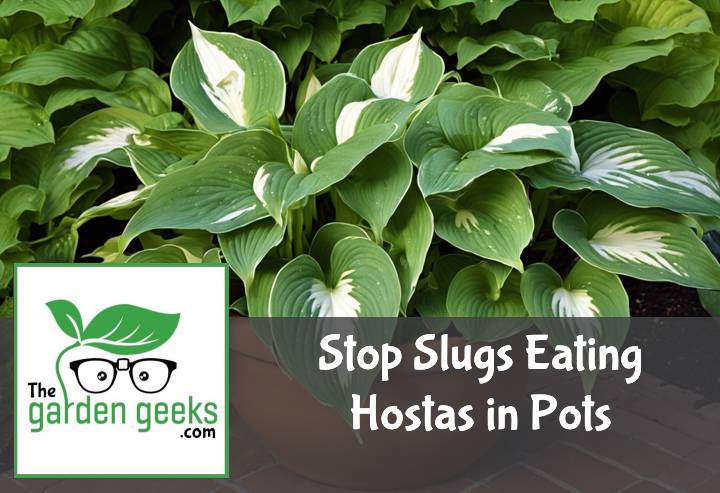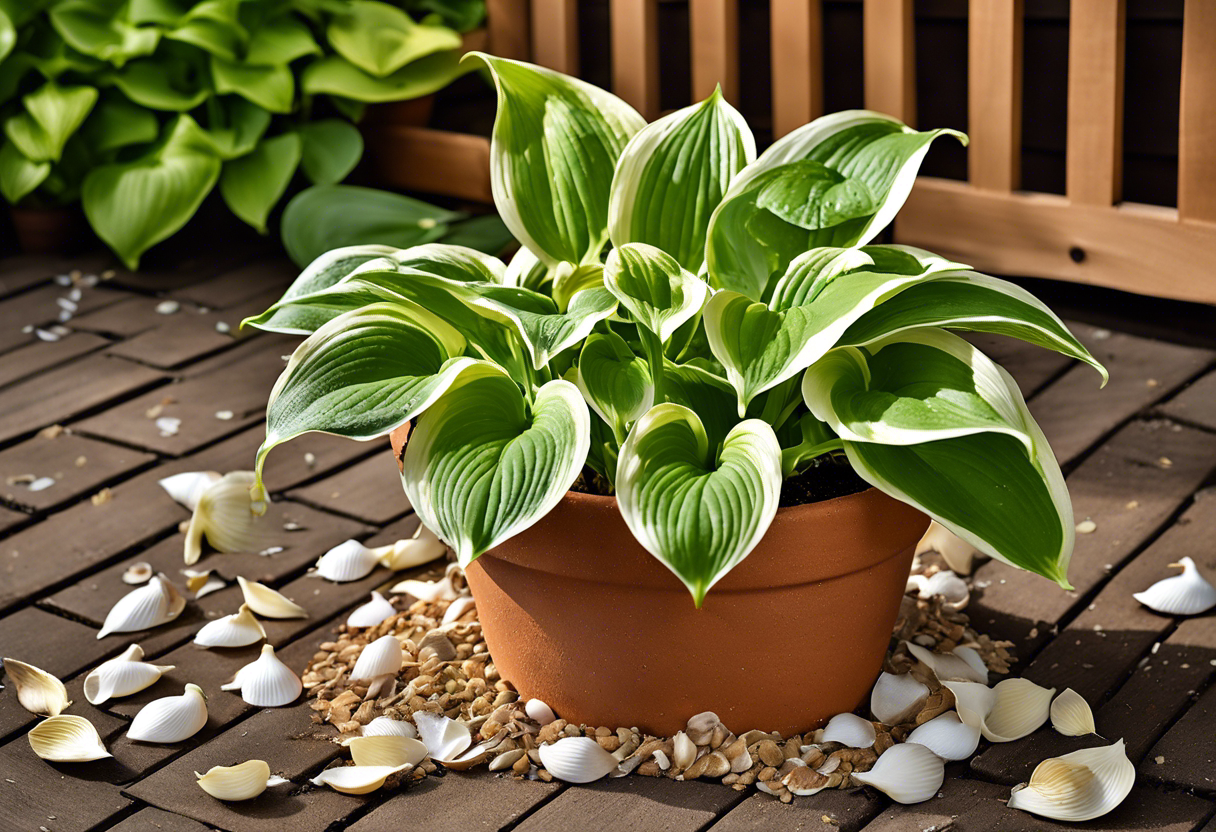Ever tried to maintain a beautiful pot of hostas, only to find them nibbled on by some sneaky slugs? I feel your pain. It’s like hosting a buffet for these slimy critters! If you’re here, you’re probably seeking ways to Stop Slugs Eating Hostas in Pots. Well, you’re in luck!
In this post, we’ll dive into three hacks that actually work. We’ll explore natural barriers, slug traps and even biological control methods. So grab your gardening gloves and let’s outsmart those pesky slugs together! Keep reading about Stop Slugs Eating Hostas in Pots (3 Hacks That Actually Work).
Key Takeaways
- Use copper tape around the pot to deter slugs as they dislike crossing copper.
- Apply a layer of grit or crushed eggshells on top of the soil, making it difficult for slugs to move across.
- Introduce natural predators like birds and hedgehogs into your garden. They can help control slug population.
- Regularly check your pots in the evening when slugs are most active and remove any you find manually.
Understanding the Problem: Why Do Slugs Eat Hostas?
Slugs munching on your precious hostas can be a real heartbreaker. But why do they do it? Well, to stop slugs eating hostas in pots, we first need to understand their behavior and what draws them to our leafy friends.
The Attraction of Slugs to Hostas
Hostas are like slug candy. They’re soft, succulent, and easy to chew – perfect for a slug’s delicate palate. Plus, they’re low-lying plants which means they’re easily accessible for these slow-moving critters. It’s not just about the taste though.
The moisture content in hostas is another major draw for slugs. These slimy fellas love damp environments and hosta leaves provide just that. So, it’s no surprise that they find hostas irresistible.
The Impact of Slugs on Hostas in Pots
Now let’s talk damage. When slugs get their grubby little mouths on your potted hostas, it ain’t pretty. They leave behind ragged holes and silvery trails – telltale signs of a slug infestation.
But it doesn’t stop there. As they feed, they also introduce bacteria and other pathogens into the plant which can lead to disease and decay over time. This can seriously affect the health of your potted hosta and if left unchecked, could even result in plant death! Now that we’ve got a handle on the problem, let’s dive into some solutions to stop slugs eating hostas in pots.
Hack 1: Natural Barriers and Deterrents
To stop slugs eating hostas in pots, you gotta get creative! And what’s more creative than using natural barriers and deterrents? They’re like the bouncers of your garden, keeping those slimy party crashers at bay.
Using Copper Tape as a Barrier
Ever heard of copper tape? Well, it’s pretty much kryptonite for slugs. Slap some around your pots and watch as the slugs turn away like vampires from garlic. It’s all about that tiny electrical charge it gives off – slugs hate it! This copper tape slug barrier is an ace up your sleeve for protecting those precious hostas.
And don’t worry about aesthetics. The shiny copper can add a nice touch to your garden decor while serving its purpose. So not only are you preventing a slug invasion, but you’re also adding some bling to your pots. Talk about killing two birds with one stone!
Implementing Eggshells or Diatomaceous Earth
Now let’s talk eggshells and diatomaceous earth – two more weapons in our anti-slug arsenal. Crushed eggshells around your pots create a jagged terrain that slugs wouldn’t dare cross. Think of it as walking barefoot on Lego bricks – not fun, right?
Diatomaceous earth works similarly, but with an added bonus: it dehydrates the little pests! Sprinkle some around your hostas and watch them retreat faster than kids from broccoli. These natural slug deterrents are cheap, effective, and they give new meaning to “eggshell security”!
Utilizing Coffee Grounds as a Deterrent
Last but not least: coffee grounds! Who knew that our morning pick-me-up could also be a slug repellent? Sprinkle used coffee grounds around your pots and let the caffeine do its magic. Slugs hate the stuff!
Not only does it deter slugs, but it also enriches your soil with nitrogen. It’s a win-win! So next time you brew a pot of coffee, remember: one person’s trash is another person’s natural slug deterrent. Now go forth and protect those hostas!
Hack 2: Slug Traps and Baits
When it comes to protecting hostas from the slimy onslaught of slugs, traps and baits are a gardener’s best friend. These methods can be quite effective in your quest to stop slugs eating hostas in pots.
Creating Beer Traps for Slugs
Ever heard of the old saying, “slugs can’t resist a good pint”? Well, it’s not exactly a common saying, but it should be! The beer trap method is a tried-and-true DIY solution for those pesky gastropods.
You see, slugs are attracted to the yeast in beer. So by setting up a small container filled with beer near your hostas, you’re essentially creating an irresistible slug party. But here’s the catch – they get so sloshed they can’t find their way out of the container.
The key to an effective beer trap is regular maintenance. You’ll need to replace the beer every few days or after heavy rain to keep attracting those boozy mollusks. Remember, stale beer is about as appealing to slugs as it is to us!
Using Commercially Available Slug Baits
If DIY isn’t your thing or you’re dealing with a serious slug infestation, commercial slug baits might be your best bet. These products contain ingredients that attract slugs and then kill them once ingested.
However, while these commercial slug baits can be highly effective, there are some potential drawbacks worth considering. Some types may pose risks to pets or other wildlife if ingested. Always read labels carefully and consider opting for pet-safe varieties if needed.
Remember folks, when used wisely and safely, these baits can play a crucial role in helping you stop slugs eating hostas in pots!
Hack 3: Biological Control Methods
Alright, let’s dive into the world of biological control. It’s a fancy term for using nature to do the dirty work and stop slugs eating hostas in pots.
Introducing Predators into Your Garden
Ever thought about inviting some guests over to your garden? No, not your neighbors, but certain garden predators that have a taste for slugs. These slug-eating species can be a great help in keeping those slimy critters at bay.
For instance, birds are natural slug munchers. Encouraging them to visit your garden can be as simple as setting up bird feeders or bird baths. Hedgehogs and frogs are also known to snack on slugs, so creating habitats for these beneficial garden animals can give you an upper hand in this battle against slugs.
Remember though, it’s all about balance. You don’t want to create a new problem while trying to solve another one. So, keep things under control and monitor the situation closely.
Using Nematodes as a Biological Control
Now let’s talk about nematodes – tiny microscopic worms that are natural enemies of slugs. They’re like secret agents in your garden soil, carrying out covert operations against these pesky pests.
You can buy specific types of nematodes (Phasmarhabditis hermaphrodita) that target slugs specifically. The application process is quite simple too – just mix them with water and spray onto the soil around your hostas.
The effectiveness of nematodes against slugs is pretty impressive! Once they enter the slug’s body, they release bacteria causing the slug to stop feeding and eventually die off.
So there you have it folks! Two effective biological pest control methods to help you stop slugs eating hostas in pots without resorting to harsh chemicals. Nature’s got your back!
Preventive Measures to Keep Slugs Away from Hostas in Pots
When it comes to stop slugs eating hostas in pots, prevention is better than cure. It’s all about choosing the right varieties and watering techniques. These are your first line of defense in slug prevention and hostas protection.
Choosing Slug-Resistant Varieties of Hostas
Slug-resistant hostas, who knew? Well, they exist! And they’re a game-changer for garden plant selection. Some popular slug-resistant varieties include ‘Blue Mouse Ears’ and ‘Sum and Substance’. They have thicker leaves that slugs find less appetizing.
These pest-resistant plants are not only tough on slugs but also look stunning in your garden. So, when you’re next selecting hostas, give these hardy varieties a try!
Proper Watering Techniques to Discourage Slugs
Watering techniques can make or break your efforts to keep those slimy critters away from your beloved hostas. Slugs love damp conditions, so overwatering is like sending them an engraved invitation!
The key is to water early in the day so the soil has time to dry out before nightfall when slugs are most active. This approach, known as slug prevention watering, can help discourage these pests.
Remember, maintaining an optimal watering schedule for hostas is crucial not just for slug control but also for the overall health of your plants. So grab that watering can and show those slugs who’s boss!
To Wrap Up
We’ve journeyed through the jungles of hosta care, learning how to Stop Slugs Eating Hostas in Pots. It’s like a game of cat and mouse, but with plants and slimy critters.
So, don’t let your hostas be a slug smorgasbord! Arm yourself with these hacks and show those slugs who’s boss. Happy gardening!





